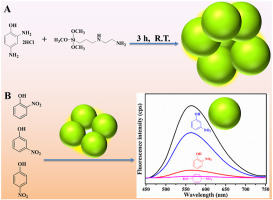Abstract
A clear formation mechanism is essential for the controllable synthesis of nanomaterials with different optical properties, which is also one of the challenges facing the preparation of fluorescent silicon nanomaterials. In this work, a one-step room temperature synthesis method was established to prepare yellow-green fluorescent silicon nanoparticles (SiNPs). The obtained SiNPs exhibited excellent pH stability, salt tolerance, anti-photobleaching ability and biocompatibility. Based on X-ray photoelectron spectroscopy, transmission electron microscopy, ultra high performance liquid chromatography tandem mass spectrometry and other characterization data, the formation mechanism of the SiNPs was proposed, which provided a theoretical basis and important reference for the controllable preparation of SiNPs and other fluorescent nanomaterials. In addition, the obtained SiNPs illustrated excellent sensitivity for nitrophenol isomers, the linear range of o-nitrophenol, m-nitrophenol, p-nitrophenol was 0.05-600 mu M, 20-600 mu M and 0.01-600 mu M under the lambda ex and lambda em were set as 440 nm and 549 nm, and related limit detection was 16.7 nM, 6.7 mu M and 3.3 nM, respectively. The developed SiNP-based sensor achieved satisfactory recoveries in detecting nitrophenol isomers in a river water sample, showing great promise in practical applications.

Keywords Plus:CARBON DOTSSELECTIVE DETERMINATIONDISCRIMINATIONPROBE
Published in TALANTA,Volume257;10.1016/j.talanta.2023.124347,MAY 15 2023


